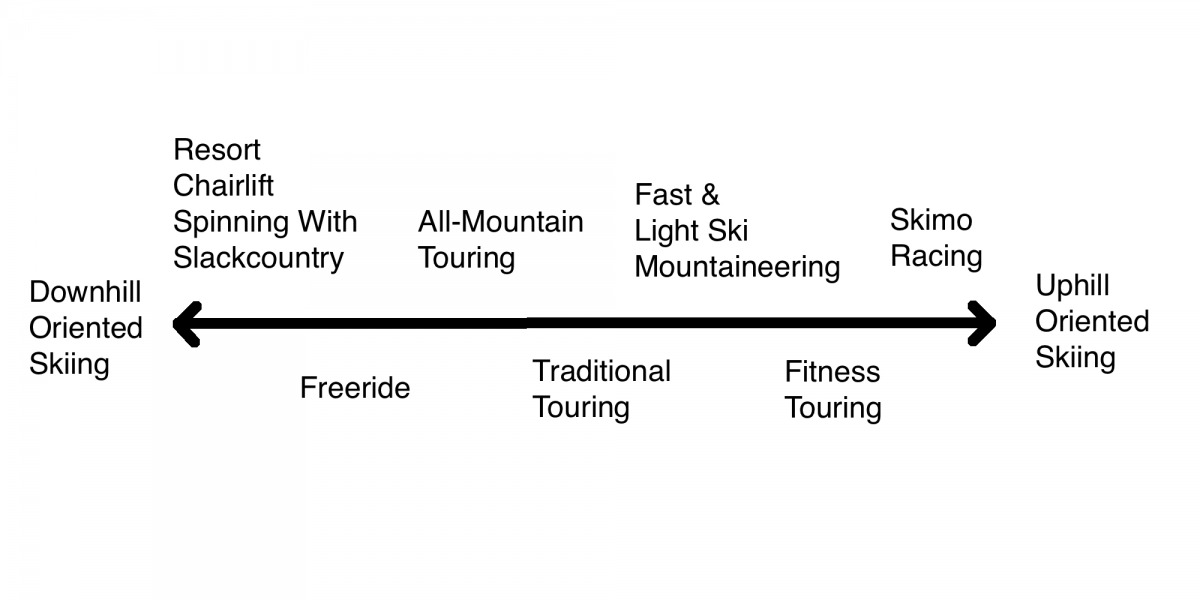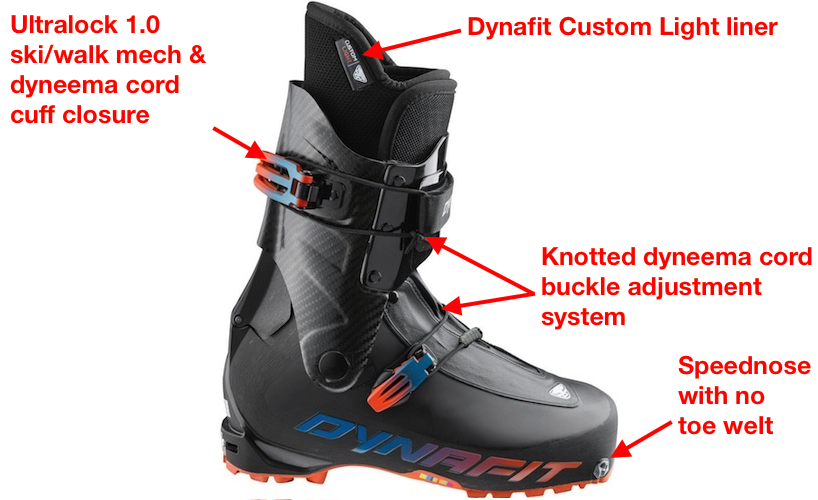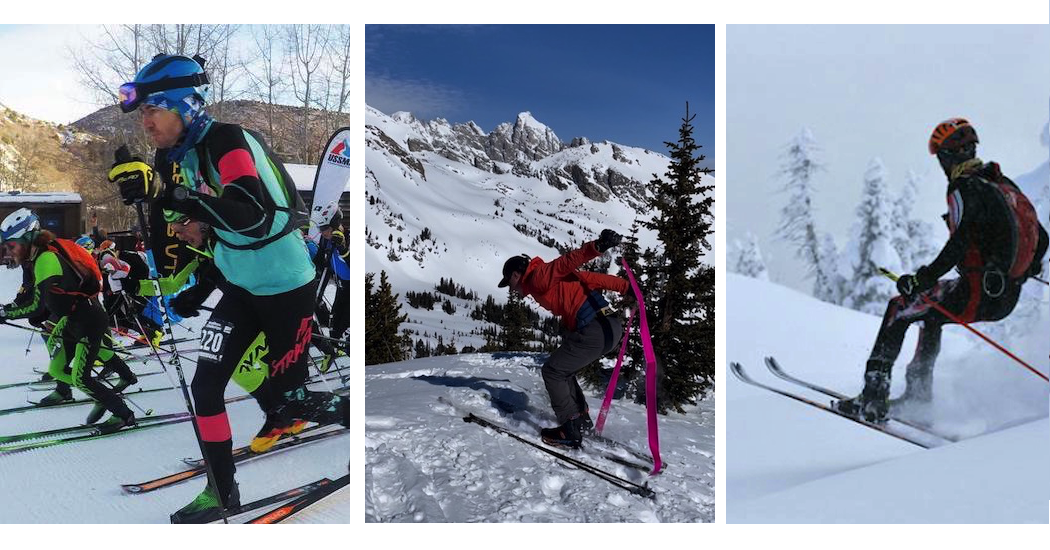
Left: Groomer touring at the beginning of a skimo race. Middle: A double skin rip (#doubleskinrip) executed in mediocre fashion. Right: Attack Turtle descent style performed flawlessly.
Is there a place for race gear in your backcountry quiver?
Raise your hand if you’ve ever found yourself craving the following experiences out of ski touring:
— Redlining while ski-jogging up a resort. Either racing against other people or alone while resort skiers heckle ‘You’re going the wrong way!’
— Transitioning at a blistering pace (ideally performing the legendary double-skin-rip).
— Descending in classic ‘Attack Turtle’ style, praying for the run to finish soon so you can get back to touring uphill.
— Weighing your gear on a scale and making a Gear Weight Spreadsheet (kit measured in grams obviously).
If you raised your hand to any/all of these (and maybe even if you didn’t), you should probably look into skimo racing. Skimo racing is a silly, intense niche of our beloved backcountry skiing community. If the subsets of ski touring were placed on a gradient from uphill to downhill oriented, skimo would slam against the uphill-oriented side of that spectrum. The gear is as light as possible while still managing to ski downhill (Check out ISMF’s shockingly strict and precise rules about gear). The intent behind the sport is to travel as fast as possible both up and down (or train to do so at some other time).
Jokes and cultural priming aside, this blog post is first and foremost a gear review, but also a commentary on the sport of skimo racing. I reviewed the Dynafit Mezzalama ski, the PDG 2 boot and the Low Tech Race 105 binding (LTR105). This race kit is capable of a solid finish at any North American skimo event. It’s also a quality training kit for resort fitness touring. The combo of Dynafit skis, bindings and boots is designed for the gram-counting, second-shaving, take-racing-seriously community.
But is that all this gear is capable of? Is there more that race gear can offer to the backcountry community, or is it confined to the packed powder of ski areas and flagged off race courses? How dreamy does it sound to log backcountry vert while moving at a skimo race pace…(I have dreams of big alpine enchainments like this, do you?) I reviewed the Dynafit race kit to get a better understanding of ‘skimo’ and test the limits of this uphill-most oriented touring equipment.
This review is broken into two parts: a narrative review of the Mezzalama ski and PDG 2 boot followed by a review of the LTR 105 binding and an epilogue of sorts sharing my lessons learned from taking race gear into the backcountry.
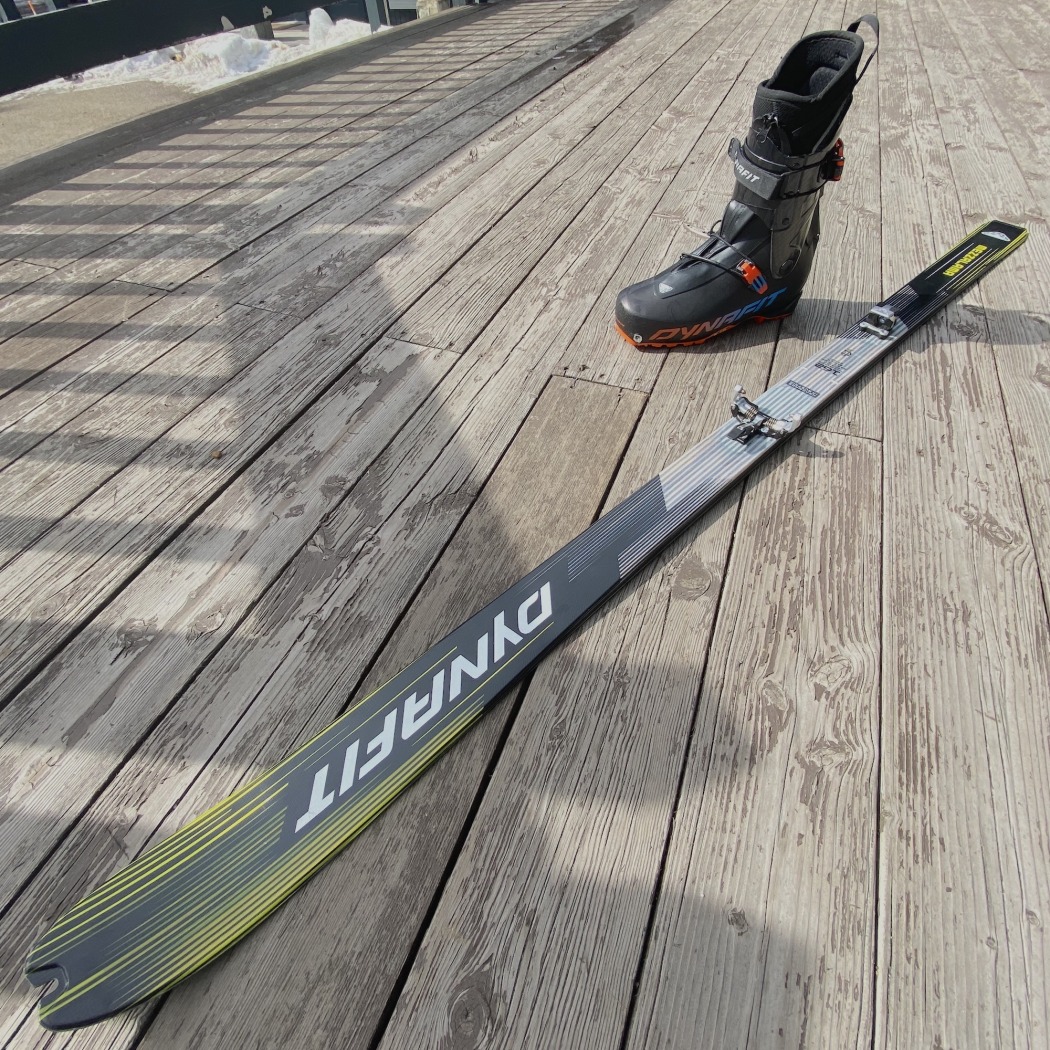
The Mezzalama ski, Low Tech Race 105 binding and PDG 2 boot make up the training-weight class of Dynafit Race gear
Mezzalama Ski
The DNA and the Mezzalama are the two skis in the Dynafit Race series:
The DNA is intended for max-effort racing. It has a paulownia/isocore (foam) core and a sheet of unidirectional carbon fiber for the highest performance/weight ratio possible. It’s the absolute lightest a race ski can be built and still has some gumption to rip downhill.
The Mezzalama is intended for training, or racing without the intention to podium. It has a full paulownia wood core and a sheet of carbon/fiberglass weave for a solid race construction. This ski adds weight to bring down the price and improve durability. For longer races or long backcountry missions, this would be my first choice.
A major pitfall with all race gear is durability. The balance between lightweight and durable is a challenging one. The Mezzalama’s 100 grams of added weight (compared to the DNA) in the form of a full wood core and added fiberglass is well worth it, IMO. This will improve the dampening and longevity of the ski in exchange for a 13% percent increase in weight…(let the gram counting begin).
The DNA and Mezzalama share the same shape and profile, making them both ski…just fine. Race skis are generally straight in shape with a huge turning radius (the Mezzalama has a 24 m radius). This big turning radius is because race skis try to maintain a 64 mm waist (that is the minimum width allowed by the ISMF). To achieve a smaller TR, they would need to add material to the tip and/or tail, thus more weight. The ski’s profile of traditional camber with a bit of tip rise helps facilitate edge engagement and alpine-style turns.
All race skis warrant a survival style of downhill skiing, so shape and profile can only do so much. At least the Mezzalama gives a bit more stability to the descent with an added sidewall and full woodcore. When I rip skins at a downhill transition, I almost without fail think: ‘Let’s get this over with.’ Is that too downbeat? Maybe there is some whimsical nuisance to Attack Turtle skiing that I haven’t yet found. I do know however that touring uphill with a pair of race skis is agile, airy, and pleasant — similar to trail running on tacky dirt. But we all know that hiking boots provide more support for long brutal descents down rocky trails…
If you are interested in long backcountry race gear missions, the Mezzalama seems to be one of the best race ski options for this type of outing. They are slightly more robust than the race weight equivalent class (like the DNA skis) and additionally more competent when skiing variable snow in the backcountry.
SPECS
Available lengths: 153, 162, tested length: 162
Dimensions (cm): Claimed: 94-64-79, Measured: 94-65-80
Weight (g): Claimed: 780, Measured: 811
Sidecut (m): 24
Construction: Paulownia wood core with vertical carbon fiber stringers and full mini sidewall
Shape: Straight ski with slight shovel
Profile: Slight tip rise with traditional camber
Skin Attachment: Tip notch and no tail attachment
MSRP: $649.95
Recommendations
Binding Pairing: Race binding like the Dynafit Low Tech 105
Boot Pairing: Race boot like the Dynafit PDG 2
Similar To: Dynastar Pierra Menta
Intended Use: Randonee training, racing…or long backcountry missions in spring conditions
Overall: A stable race ski that is still light enough to be competitive
PDG 2 Boot
The PDG 2 boot is the equivalent category of boot to the Mezzalama ski: It’s a slightly heavier race boot that provides backcountry-possible travel in a featherweight package. The lighter race boot made by Dynafit is the DNA, which is a rebranded Pierre Gignoux full carbon race boot. Most brands (Scarpa and La Sportiva) have this theme of full carbon option and less expensive, heavier, more robust carbon cuff option. The DNA is indeed a work of skimo craftsmanship to admire, but can barely be called a ski boot for how delicate it is. I would leave the DNA boot to ISMF competitors and/or people who want a 500 gram, full-carbon mantle piece to admire (too much?).
The PDG 2 is a work horse race/training boot that can handle more use and abuse than the full carbon DNA. A few points on the PDG 2:
It features a Grilamid shell and carbon fiber cuff. The shell is a high volume fit (maybe the highest volume of any race boot), which is good for all of the HV skimo fiends out there. The carbon cuff sits unusually low up the shin and calf. I’ll use that as an excuse for the braced survival stance I tend to find myself in while skiing downhill in these boots.
There is one cuff and one shell buckle which are both adjusted with knotted dyneema cord. The shell buckle leaves something to be desired. Located on the crown of the foot, it effectively collapses your arch when tightened down. I run the shell buckle loose to avoid the buckle-promoted foot cramping and it seems to work out fine.
The cuff buckle features Dynafit’s proprietary Ultralock 1.0 closure system. When in walk mode, the ski/walk mech lays on the outside of the boot and can frequently get caught by a passing ski pole or a low hanging tree branch. This is less than ideal compared to more standard vertically-oriented walk mechs.
These boots have the Dynafit Speednose which brings the tech toe inserts closer towards your foot to provide a more natural stride while touring. I can’t tell the difference (yet). This design also means you don’t have a toe welt and need proprietary Dynafit Cramp-in crampons.
The PDG 2 features a bikini-style liner gaiter. It’s a flap of vinyl-coated fabric that is secured around the rear of the liner with an elastic strap and a waterproof zipper in front. This feels like a snap-on tie version of a waterproof liner and left my feet unfortunately swampy after every outing when I wasn’t skiing groomed snow.
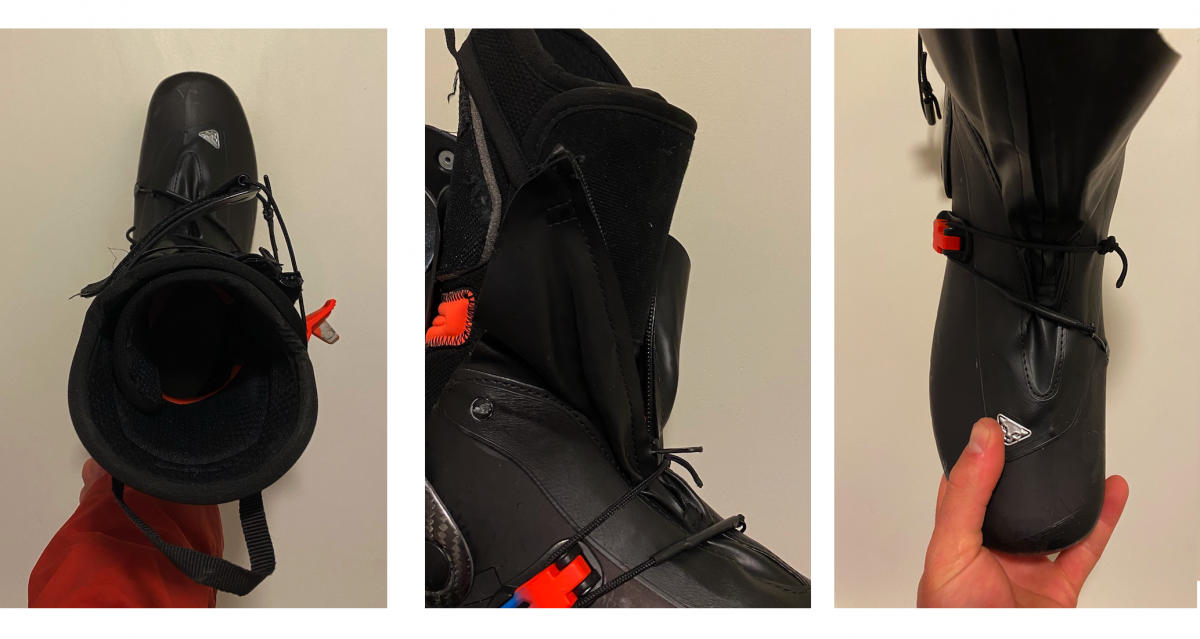
Left: A top view of the boot in walk mode with the Ultralock 1.0 buckle in a prime pole or tree branch snagging position. Middle: The bikini liner gaiter has lackluster elastic webbing to hold it up and insufficient coverage to keep out moisture. Right: The shell dyneema cord closure system is located on top of the foot where I find it to collapse the arch if appropriately buckled down.
Overall, the PDG 2 feels to me like a transitional boot; a boot that experimented with blending different Dynafit design concepts to see what works and what doesn’t. I say this with a hint of deductive reasoning because Dynafit plans to debut their new and improved race boot lineup for Fall 2021 (Check out more on that here). Both of the new FW21 Dynafit boots have an improved ski/walk mech, BOA-style shell buckle system, a more robust cuff closure system, and what looks to be an improved waterproof liner cover. We’re excited to try them out.
SPECS
Available Sizes: 22.5-30.5, tested size: 28 (BSL=293 mm)
Fit Tester street shoe size: USM 10, low volume forefoot and ankle, high volume calf
Forefoot: Wide, feels like a ~102 mm last
Ankle: Wide, no pressure on either side of ankle
Cuff: Low, taller high back, but low resting overlap
Last: Feels like a 102 mm (no manufactured stated spec)
Mass:, Claimed: 827g [27.5], Measured: 904g
Flex none stated, Qualitative Flex: less than Scarpa Alien 1.0, more than Atomic Backland Ultimate
Flex Character: rigid, brick wall carbon cuff, little lateral deformation in the shell with flex
Buckles: Shell dyneema cord closure / Cuff dyneema cord closure
Ski/Walk Mechanism: Ultralock 1.0 – horizontal orientation attached to the shell dyneema cord closure
Claimed Cuff Articulation: 62°, Articulation quality: Very free
Claimed forward lean: 14°
Liner: Dynafit Custom Light liner, 140 g
Materials: Grilamid shell, Carbon fiber cuff
Sole: Pomoca Race
Binding Compatibility: Tech only
Moldable liner: Yes
Punchable shell: Yes
MSRP: $899.95
Recommendations
Binding Pairing: Race binding like the Low Tech Race 105
Ski Pairing: Race ski like the Mezzalama
Similar To: Scarpa Alien 1.0 or La Sportiva Raceborg
Intended Use: Skimo racing, training or long mellow backcountry endeavors
Overall: HV raceboots that can crush racing or training and manage backcountry tours
That’s it for part one of our grand skimo race review. Tune into part two for the LTR105 binding, a recap of skiing the setup in the backcountry, and general conclusions on the kit.
Shop for the Dynafit Mezzalama ski and PDG 2 boot
Slator Aplin lives in the San Juans. He enjoys time spent in the mountains, pastries paired with coffee, and adventures-gone-wrong. You can often find him outside Telluride’s local bakery — Baked in Telluride.

